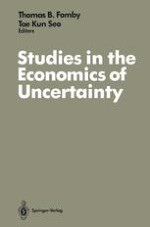1989 | OriginalPaper | Buchkapitel
The “Comparative Statics” of the Shackle-Vickers Approach to Decision-Making in Ignorance
verfasst von : Donald W. Katzner
Erschienen in: Studies in the Economics of Uncertainty
Verlag: Springer New York
Enthalten in: Professional Book Archive
Aktivieren Sie unsere intelligente Suche, um passende Fachinhalte oder Patente zu finden.
Wählen Sie Textabschnitte aus um mit Künstlicher Intelligenz passenden Patente zu finden. powered by
Markieren Sie Textabschnitte, um KI-gestützt weitere passende Inhalte zu finden. powered by
The analysis of decision-making under conditions of ignorance developed by Shackle [8] and Vickers [9], [10] begins with the assumption that the decision-maker is able to describe a potential surprise function defined over the subsets of an incomplete2 collection of possible outcomes or states of the world.3 The potential surprise of an outcome-set A is the surprise the decision-maker imagines now that he would experience in the future were A to occur. Let a decision set containing the objects of choice be specified, and suppose that the decision-maker has an ordinal utility function defined over the Cartesian product of the decision set and the incomplete collection of states of the world. For each state of the world, then, the utility function maps objects of choice or elements of the decision set into associated utility values. More importantly, for each object of choice, the utility function also maps states of the world into utility values. Using this latter relation, the potential surprise function can be translated into a potential surprise density (or frequency) function4 defined over utility values. Thus the original potential surprise function, whose domain is a collection of outcome-sets, becomes a potential surprise density function with a domain consisting of utility magnitudes, or real numbers. Although it has a different significance and meaning, the potential surprise density function is often drawn to look something like an inverted probability density function.
